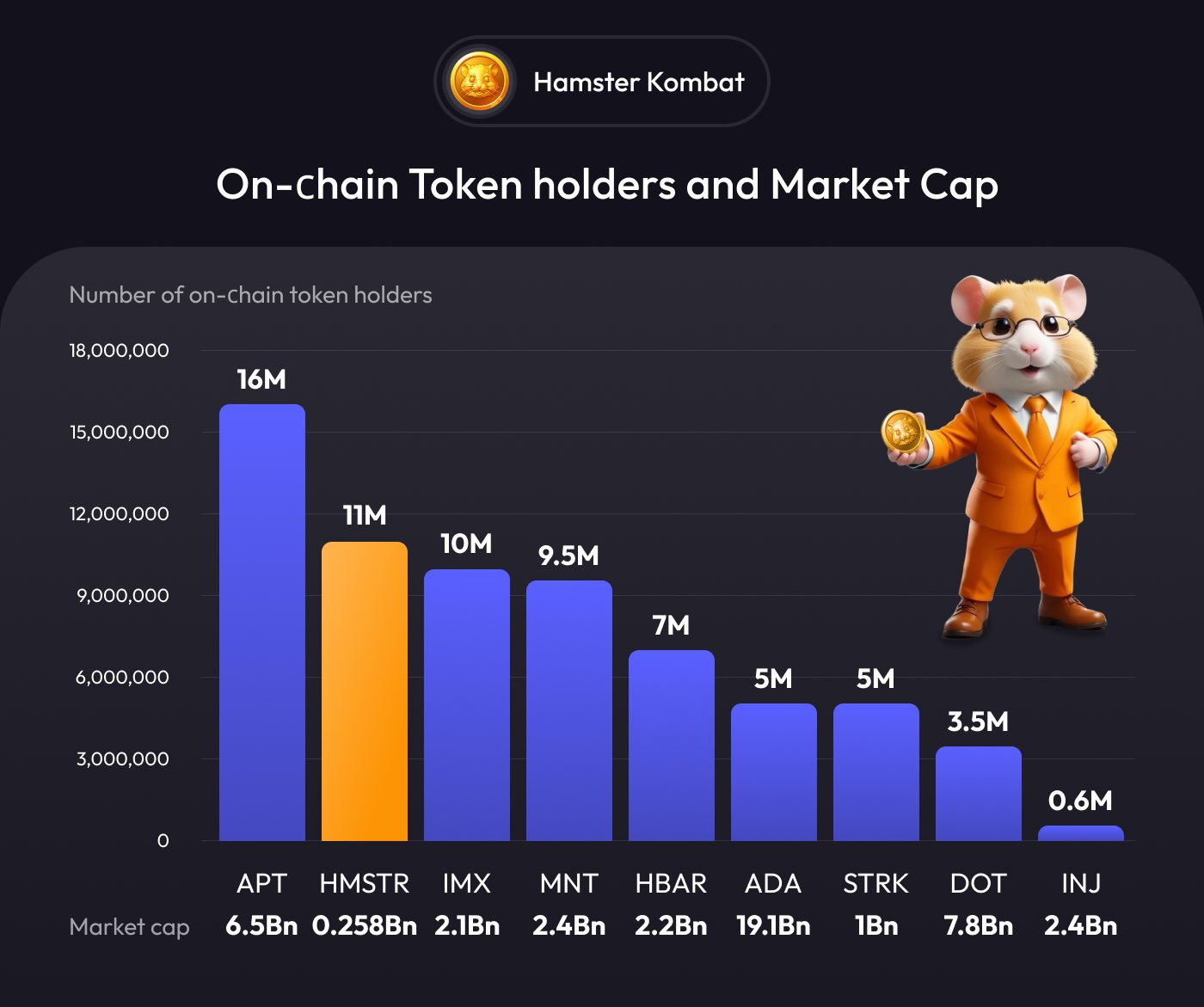GameFi Edition: Hamster Kombat’s Rise and Fall - Lessons for the Future of GameFi
How Hamster Kombat’s Viral Success and Collapse Shaped the Future of GameFi
When Hamster Kombat launched in March 2024, it became an instant sensation. The game’s absurd premise of hamsters operating cryptocurrency exchanges, paired with a sharp critique of speculative cryptoeconomics, captured the imagination of over 300 million players globally. It wasn’t just a game; it was a phenomenon that seamlessly blended satirical humor, blockchain integration, and user-friendly mechanics. Its success was further amplified by a clever integration with Telegram, which eliminated friction during onboarding and tapped into a massive pre-existing user base.
However, Hamster Kombat’s rise was as meteoric as its fall. While it demonstrated how GameFi projects can leverage virality and memetic appeal to achieve tremendous scale, it also underscored the fragility of platforms lacking robust retention mechanisms. Within months, the active user base had dwindled from the hundreds of millions to just over 40 million. Despite this sharp decline, the game remains an important case study, offering valuable lessons on the intricate dance between accessibility, humor, and cryptoeconomics in the decentralized gaming ecosystem.
A World of Taps and Tokens
At its core, Hamster Kombat combined the repetitive simplicity of idle clicker games with light strategic gameplay. Players earned in-game currency by tapping their screens and investing these earnings into upgrades for their hamster-operated exchanges. The progression loop was straightforward yet satisfying, appealing to casual gamers while offering hints of deeper systems for those willing to engage on a more strategic level.
The game encouraged daily play through a series of engagement mechanisms. Players were incentivized with combo puzzles, task chains, and time-sensitive rewards that added a layer of ritual to the experience. This design tapped into a habitual rhythm, ensuring that players kept coming back to maintain their progress and reap their daily rewards.
The satirical tone of Hamster Kombat wasn’t just for entertainment. It reflected the speculative frenzy of crypto markets, offering a tongue-in-cheek commentary on the chaotic ethos that drives much of the blockchain space. For crypto enthusiasts, this humorous mirroring made the game not only engaging but deeply relatable, turning every tap and upgrade into part of a larger conversation about the absurdities of the crypto economy.
The Role of Tokenomics in the Game’s Meteoric Rise
While the simplistic gameplay captured attention, it was the HMSTR utility token that truly drove the project’s popularity. Designed to foster community ownership and incentivize participation, the tokenomics plan was ambitious. A significant portion of the token supply—60% to be exact—was distributed via generous airdrops, allowing the developers to create immediate excitement and inclusivity. Players quickly adopted HMSTR as a medium of exchange within the game, using it to purchase power-ups, unlock premium features, and participate in exclusive events.
This wasn’t where the ambitions stopped. Plans for staking mechanics and DAO integration signaled a forward-thinking vision to crypto-savvy players. HMSTR was positioned as the foundation for potential future expansions, with promises of cross-platform functionality and even broader utility across a so-called Hamster Kombat Universe.
Yet, as is often the case in fast-growing token economies, initial hyperactivity is difficult to sustain. Once the momentum began to slow, the HMSTR token’s value faltered. It lost over 75% of its trading value in a matter of months, which not only undermined the token’s appeal but also shook confidence in the game’s reward structures. This token instability became one of the key contributors to player attrition, reflecting a core challenge of maintaining equilibrium in crypto-based gaming economies.
From Viral Success to Rapid Burnout
It’s essential to understand what fueled Hamster Kombat’s viral growth to appreciate its collapse. The game’s Telegram-native integration was an inspired choice for scaling. By embedding itself within the Telegram platform, the game removed barriers to entry and leveraged an existing audience of crypto enthusiasts. The free-to-play model further broadened the appeal, attracting casual gamers alongside blockchain veterans.
The referral system was another stroke of genius, effectively turning each player into a marketer. Early adopters recruited friends en masse, drawn by the tiered rewards that promised escalating benefits as their networks grew. At its peak, Hamster Kombat dominated a significant portion of crypto-gaming discussions, and its memetic appeal—as hamsters running exchanges is inherently ludicrous yet oddly endearing—added fuel to its exponential growth.
But for all its success at drawing players in, the game struggled to keep them around. The biggest problem? Repetition. The tap-to-earn mechanics were addictive, but only up to a point. Once the initial novelty wore off, the gameplay loop began to feel shallow. Without deeper progression systems or meaningful social interactions, players had little reason to stay engaged after reaching key milestones.
Compounding this, roadmap delays eroded trust. Features that had been hyped, such as NFT integration and seasonal content drops, failed to materialize on schedule. This lack of timely execution made it difficult to sustain excitement, and the loss of faith rippled outward. Promises of a broader game ecosystem started to feel like empty marketing rather than a legitimate development plan.
On top of that, the game failed to build out meaningful multiplayer features. While players were competing on global leaderboards, they didn’t have opportunities for real-time interaction, collaboration, or governance. It became clear that, for many, Hamster Kombat was a novelty rather than a lasting community-driven experience. And with a declining user base came the inevitable token devaluation, feeding into a cycle of further attrition.
Unpacking the Lessons for GameFi Creators
Despite its rapid fade, Hamster Kombat offered the GameFi ecosystem a wealth of insights. At a time when many projects are focused on replicating viral growth, the game exposed the limitations of scaling without substantive long-term strategies.
One key takeaway is the balance between accessibility and retention. While free-to-play models and referral systems can drive adoption, games need enough depth and evolution to keep users engaged beyond the initial rush. Progression systems, diverse content, and social mechanics like multiplayer features or DAO governance are essential for building lasting communities.
Another critical lesson lies in tokenomic design. To maintain value and user confidence, game economies must be thoughtfully engineered to absorb shocks and avoid overspeculation. Features like controlled inflation, deflationary mechanisms, and staking rewards can create an environment where users feel incentivized to stay involved for the long term.
Equally important is execution. When Hamster Kombat failed to meet roadmap milestones, it set off a chain reaction of disappointment that amplified user attrition. GameFi developers must prioritize clear communication and timely delivery of promised features to sustain community trust.
Lastly, Hamster Kombat reminds us of the importance of lifecycle planning. Viral projects may burn brightly at first, but without deliberate strategies for reactivation and retention, that flame can fade just as quickly. Seasonal campaigns, episodic content updates, and persistent social systems are vital tools for extending a game’s relevance.
Looking Forward
Hamster Kombat may no longer enjoy the overwhelming success it did at launch, but it remains a landmark moment in the GameFi space. It proved the viability of Telegram-native gaming and demonstrated how humor and accessibility could attract a massive, diversified audience. At the same time, its abrupt decline serves as a cautionary tale, emphasizing the need for strategic depth and long-term vision in decentralized gaming.
For developers entering the GameFi arena, the lessons of Hamster Kombat are invaluable. Rapid scale is thrilling, but the real challenge lies in sustaining it. Only by combining engaging gameplay, well-designed tokenomics, and robust community features can projects transform from viral hits to enduring ecosystems that truly define the future of decentralized gaming.
What do you think is the most important lesson from Hamster Kombat’s rise and fall? Can the GameFi industry learn to balance virality with sustainability? Share your thoughts in the comments.
Don’t forget to subscribe for more deep dives into GameFi trends and other groundbreaking blockchain innovations shaping the future of decentralized gaming!












